| | KRO Tomorrow's Winners A&F October 2013
Publisher: Kaiser Research Online
Author: Copyright 2013 John A. Kaiser
|
| |
KRO Theme Index: KRO Tomorrow's Winners A&F October 2013
| Index Criteria: The 8 companies featured in this KRO Tomorrow's Winners Index were open KRO recommendations selected to participate in a mini-conference "Resource Investing with John Kaiser" organized by Academy & Finance in Geneva on October 1, 2013 and in Zurich on October 3, 2013. |
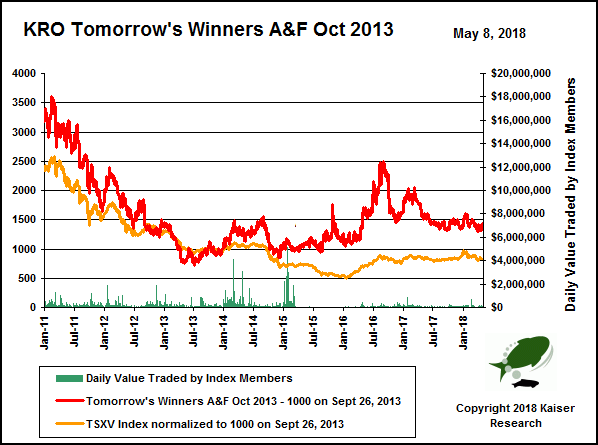


| Index Method: Each member of a KRO Index is assigned a value of $1,000 when added to the index, which is divided by the closing stock price on the inclusion date to arrive at a quantity of shares which remains constant during the life of the index. In the event of a split or consolidation, the quantity is adjusted by that ratio. If a company is divided into separate entities, the surviving entity that meets the index criteria has its quantity recalculated by dividing the prior day value by the subsequent closing price of the surviving entity. If a company is delisted pursuant to a takeover bid or merger, the value on the delisting day remains part of the index and the total members will include that company. The same applies to companies which have lost their eligibility. The value of the index is the total value divided by the number of members, which will be 1000 at the official start date. The value of the TSXV Index on the offcial start date is normalized to 1000, and the resulting factor is used to adjust the TSXV Index for comparison purposes. |
| Index Start Date | September 26, 2013 | Current Date | May 8, 2018 |
| Index End Date |
| Current Value | 1379.3 |
| Index backdated to | January 4, 2011 | Total Members | 8 |
| KRO Tomorrow's Winners A&F October 2013 - Members as of May 8, 2018 |
|---|
| Ceased to be index members due to delisting or ineligibility - their value is frozen as of the end date and included in the daily index calculation. |
|---|
| Underwent a rollback or split which resulted in an adjustment to the share quantity used in the member's index value calculation. |
|---|
| Company | Active | Start | End | Quantity | Weight | Value | Chg |
|---|
| Avrupa Minerals Ltd (AVU-V) | Yes | 9/26/2013 |
| 9,091 | 7.4% | 818 | (18.2%) |
| Diagnos Inc (ADK-V) | Yes | 9/26/2013 |
| 14,286 | 9.1% | 1,000 | 0.0% |
| FPX Nickel Corp (FPX-V) | Yes | 9/26/2013 |
| 4,545 | 6.4% | 704 | (29.6%) |
| InZinc Mining Ltd (IZN-V) | Yes | 9/26/2013 |
| 16,667 | 17.4% | 1,917 | 91.7% |
| Namibia Rare Earths Inc (NRE-V) | Yes | 9/26/2013 |
| 5,000 | 14.3% | 1,575 | 57.5% |
| Nevada Exploration Inc (NGE-V) | Yes | 9/26/2013 |
| 9,524 | 21.6% | 2,381 | 138.1% |
| Probe Mines Ltd (PRB-V) | Yes | 9/26/2013 | 3/16/2015 | 461 | 18.1% | 1,996 | 99.6% |
| Uravan Minerals Inc (UVN-V) | Yes | 9/26/2013 |
| 14,286 | 5.8% | 643 | (35.7%) |
| KRO Tomorrow's Winners A&F October 2013 - May 8, 2018 - Relative Index Performance |
|---|
| Company | Days
Out or Under
Perf | Chg | Days
Out or Under
by 5% | Chg | Days
Out or Under
by 10% | Chg |
|---|
| Diagnos Inc (ADK-V) | 2 | 9.3% | 1 | 7.0% | 0 | 0.0% |
| FPX Nickel Corp (FPX-V) | 1 | 6.2% | 1 | 6.2% | 0 | 0.0% |
| Uravan Minerals Inc (UVN-V) | 0 | 0.0% | 0 | 0.0% | 0 | 0.0% |
| Namibia Rare Earths Inc (NRE-V) | (1) | (0.7%) | 0 | 0.0% | 0 | 0.0% |
| InZinc Mining Ltd (IZN-V) | (1) | (0.7%) | 0 | 0.0% | 0 | 0.0% |
| Avrupa Minerals Ltd (AVU-V) | (2) | (8.7%) | (1) | (5.9%) | 0 | 0.0% |
| Nevada Exploration Inc (NGE-V) | (3) | (14.2%) | 0 | 0.0% | 0 | 0.0% |
| Counts the consecutive days an index member has out or underperformed its index - ie to outperform a stock's index member value increased by a greater percentage than the index gain, or its percentage loss was less than that of the index. Negative numbers are consecutive underperform days. Change is the sum of the percentage by which the index member out or underperformed the index on each consecutive day. There is no summing of positive and negative numbers. |
| Avrupa Minerals Ltd, headed by CEO Paul Kuhn, is a Europe-focused prospect generator that has projects in Portugal, the former East Germany and Kosovo. Kuhn has targeted old mining districts in Europe where he is either rethinking the geology, as is the case with the Iberian Pyrite Belt prospects in Portugal where his reinterpretation of the stratigraphic sequence that hosts world-class Neves Corvo style VMS deposits has opened up the Alvalade "segment" to new drilling strategies, applying alternative deposit models to districts such as Germany's Erzgebirge where tin rather than gold was the historic target metal, or picking up prospects in a region like Kosovo which not long ago was a battleground. The flagship play is the Alvalades JV on which Antofagasta spent $6.5 million to earn 60% before transferring the option to Colt Resources Ltd in 2015 which mounted a 5,000 m drill program in late 2015. Colt can earn up to 80%, leaving Avrupa with a carried through production 20% net interest. Avrupa will net 15% in the Covas tungsten project in Portugal if Blackheath Resources Inc spends euro 2,651,000 by March 2017 (euro 1.3 million spent by Q1 of 2015). An initial 43-101 tungsten resource was published in March 2015 for this former producing deposit. In Kosovo Avrupa nets 15% in the Slivovo polymetallic project if Byrnecut Intl Ltd delivers a PFS by April 2017. Slivovo yielded a high grade gold discovery hole in Q4 of 2014 that followup work indicated had modest tonnage potential. Slivovo also has an epithermal target called Xzemail. Avrupa owns 85% of the Oelsnitz project in Germany's Erzgebirge for which it is seeking a farmout partner. | 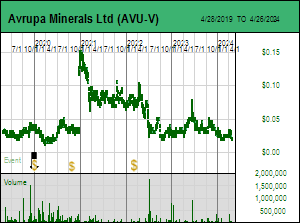 |
| Issued: | 93,793,797 | Working Capital: | $27,102 |
| Diluted: | 142,061,047 | As Of: | December 31, 2017 |
| Membership Start Date | September 26, 2013 | Price at Start | $0.11 |
| Membership backdated to | January 4, 2011 | Membership Quantity | 9,091 |
| Quick Note by JK on September 26, 2013: Avrupa Minerals Ltd fits the mold of a traditional prospect-generator where management invests a small amount of capital to generate a prospect and dress it up for farmout to a major or another junior which incurs heavy exploration costs in exchange for a majority interest in the reward. A prospect-generator like Avrupa wins by turning itself into a "perpetual lottery ticket" whereby the shareholders always have a new prospect in the wings on which they can pin their hopes for a big score even as the partner kills the one in the limelight. It is a statistics game where the goal is to minimize dilution from equity financings needed to fund exploration programs which, thanks to the cruelty of mother nature, rarely yield up a no-brainer discovery intersection. The downsides are that the prospect-generator typically does not control the news flow or exploration pace, and in bear markets has a hard time attracting majors and juniors onto whom the exploration risk can be shifted. What makes Avrupa interesting in the current bear market is that Paul Kuhn has targeted old mining districts in Europe where he is either rethinking the geology, as is the case with the Iberian Pyrite Belt prospects in Portugal where his reinterpretation of the stratigraphic sequence that hosts world-class Neves Corvo style deposits has attracted Antofogasta as a partner, applying alternative deposit models to districts such as Germany's Erzgebirge where tungsten rather than gold was the historic target metal, or picking up prospects in a region like Kosovo which not long ago was a battleground. Avrupa also lacks competition as a prospect generator because not many juniors have exposure to Europe, where accessibility and political stability stand out as developing regions in Asia, Africa and Latin America embrace resource nationalism. |
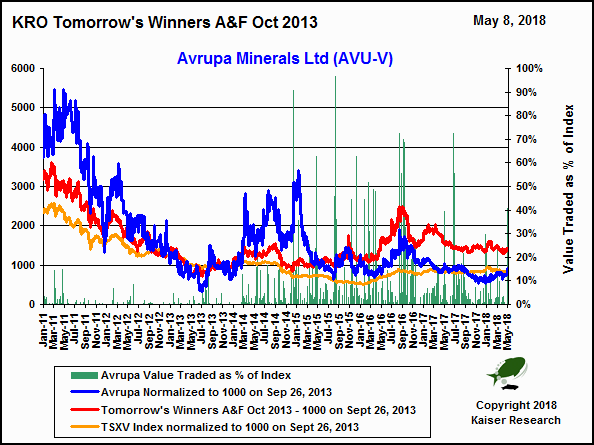 |
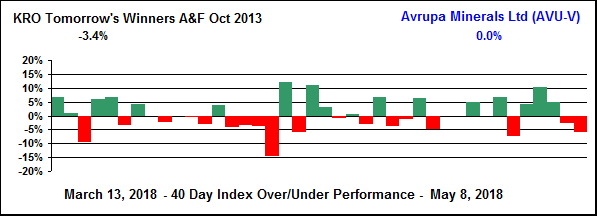 |
| Led by President Andre Larente, Diagnos employs statistical analysis and modeling to assist exploration companies. The company works with property holders by acquiring royalties in exchange for data analysis and target generation. |  |
| Issued: | 172,421,265 | Working Capital: | $979,031 |
| Diluted: | 191,217,949 | As Of: | December 31, 2017 |
| Membership Start Date | September 26, 2013 | Price at Start | $0.07 |
| Membership backdated to | January 4, 2011 | Membership Quantity | 14,286 |
| Quick Note by JK on September 26, 2013: Diagnos Inc is an unusual resource junior in that instead of generating new exploration data through fieldwork it applies pattern recognition algorithms rooted in artificial intelligence theory to existing data sets to generate new targets for projects where past work identified smoke but no fire. These data sets can consist of large scale regional data generated by government geological surveys such as is the case in Canada, smaller scale data that becomes part of the public domain through assessment work filing obligations, and proprietary data held by the existing owner of a mineral prospect. Historically geologists have had to engage in a laborious, time consuming process to load this data "into their heads" in order to visualize new targets. The quandary is that the geologist who "knows" the geology is too tunnel-visioned to see beyond what is already known, and a fresh pair of eyes is overwhelmed by the sheer volume of data. Diagnos is a pioneer in that it deals with the huge amount of digital data that has emerged during the past two decades by crunching it with "computer assisted resource discovery software" or CARDS which "learns" the signatures of known deposits on which basis it interpolates existing data to generate new targets that require field follow-up. This approach is particularly relevant in the current bear market where capital for grassroots exploration is scarce, for it exploits sunk costs to revitalize a project's potential, which is important in a market hungry for new discoveries. Diagnos provides this service to clients who already own a property in exchange for fees and discovery-linked royalties, for its own account to generate local staking acquisition targets it can option to other juniors, and through strategic alliances whereby it retains a carried interest or royalty in large regional plays. In addition to accumulating a large royalty portfolio, Diagnos uses the service fee revenue to subsidize another AI driven division, "computer assisted retinal analysis" or CARA, which provides digitally enhanced retinal images for diabetes diagnosis by healthcare professionals. Launched in 2008, CARA has reached the commercialization threshold, and, given the size of the growing diabetes crisis, could prove a very valuable business for Diagnos that offsets the risk of an extended resource sector bear market. |
 |
 |
| Apr 6, 2018 | Diagnos Inc. Sells 10,500,000 Common Shares Of Albert Mining Inc. |
| Apr 4, 2018 | Welcomes Dr. Reid Maclellan to the Board of Directors |
| Mar 14, 2018 | The Opening of a Screening Clinic at Chaparral's Health Management Wellness Center for Medicare Beneficiaries |
| Mar 7, 2018 | Following a successful year, DIAGNOS Announces a One Year Agreement in United Arabs Emirates with a Major Pharmaceutical Company |
| Feb 27, 2018 | After Successful Screening Of 2,500 Patients As Part Of A Pilot Project With Kanhoor Medical Co, DIAGNOS Will Now Screen 35,000 patients In The Kingdom Of Saudi Arabia |
| FPX Nickel Corp, which changed its name from First Point Minerals Corp on Aug 25, 2017, is led by founder Peter Bradshaw and run by CEO Martin Turenne with a focus on the discovery and development of a very low grade type of nickel deposit characterized by a nickel-iron alloy mineral called "awaruite", a form of natural stainless steel created when ultramafic rocks of an ophiolite nature undergo a metamorphism that squeezes the nickel out of the olivine lattice. Metallurgical studies indicate that this nickel-iron alloy is recoverable through gravity and magnetic separation methods if the grain size is large enough. Cliffs Natural Resources Inc spent $22 million from 2010-2013 to deliver a PEA for a 114,000 tpd open pit mine with a gravity-magnetic separation flow-sheet that would produce 37,000 tonnes of nickel annually in the form of a nickel-magnetite concentrate that steelmakers could use directly as a feedstock for stainless. The 24 year mine life was based on an I+I resource of 925 million tonnes of 0.118% nickel (Davis Tube) with a recovery of 82%. The deposit is located in central British Columbia within reasonable proximity of rail and power infrastructure. After vesting for 60% Cliffs underwent a hostile management change which resulted in FPX acquiring Cliff's 60% stake in Sept 2015 for US $4.75 million, funded by a US $5 million 5 year loan fromma third party which also got a 1% NSR. An FPX insider group bought Cliffs' 14.4 million share block and has since funded FPX with a series of no warrant private placements. A drill program in 2017 found the limits of the higher grade SE Baptiste zone. In Feb 2018 FPX published an updated resource estimate with a $6/lb nickel assumption. The plan in 2018 is to update the PEA and drill the Van target 6 km NE of Baptiste where larger grain size and grade potential exists. |  |
| Issued: | 139,187,005 | Working Capital: | $798,157 |
| Diluted: | 147,387,005 | As Of: | September 30, 2017 |
| Membership Start Date | September 26, 2013 | Price at Start | $0.22 |
| Membership backdated to | January 4, 2011 | Membership Quantity | 4,545 |
| Quick Note by JK on September 26, 2013: First Point Minerals Corp has targeted a very low grade style of nickel mineralization which lends itself to large scale, simple and low cost processing to produce a nickel-iron concentrate that can be shipped directly to stainless steel makers. Partner Cliffs Natural Resources Inc, whose goal is to become a complete input provider for the North American steel industry, has spent over $20 million to deliver a PEA for the Decar project in British Columbia, and is now proceeding to fund a prefeasibility study. First Point in turn is scouting the world for similar awaruite deposits using its certified proprietary assaying method to efficiently identify these large deposits. The nickel market is under siege from nickel-pig-iron produced in China using low grade laterite ore shipped directly from Indonesia and the Philippines. This new supply not only stresses the profit margins of traditional laterite and sulphide nickel producers but creates a nickel price lid that will inhibit the development of new nickel supply from conventional sources. First Point's nickel strategy has a key cost advantage because it is not energy intensive, does not require reagents, and generates environmentally benign tailings. Its success would turn it into a takeover target for a producer eager to carve out a profitable slice of the nickel supply feasible in a $6-$10/lb bound price range and able to benefit from higher prices as pure profit. |
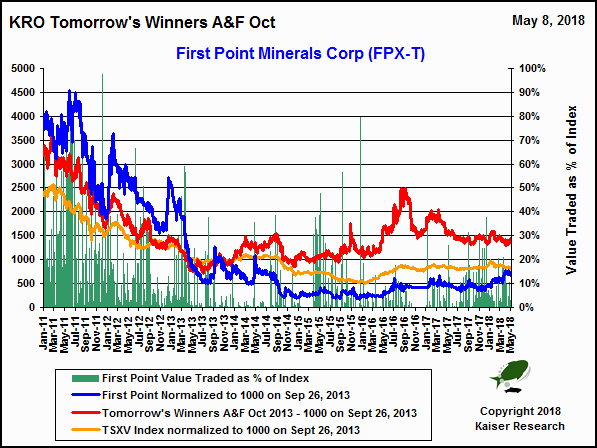 |
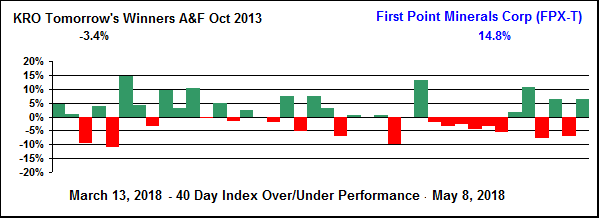 |
| May 7, 2018 | Discovery Watch with HoweStreet.com - 0:12:24 |
| May 2, 2018 | Bottom-Fish Comment: What do the rocks in Oman have to do with FPX Nickel? |
| Mar 2, 2018 | Discovery Watch with HoweStreet.com - 0:07:10 |
| May 19, 2017 | Discovery Watch with HoweStreet.com - 0:26:52 |
| May 15, 2017 | Bottom-Fish Comment: First Point to drill higher grade Baptiste southeast extension at Decar |
| Feb 3, 2017 | Discovery Watch with HoweStreet.com - 0:00:00 |
| Jan 12, 2017 | SVH Tracker: Recommendation Strategy for First Point Minerals Corp |
| Nov 9, 2016 | Discovery Watch with HoweStreet.com - 0:08:51 |
| Mar 23, 2016 | SVH Tracker: Recommendation Strategy for First Point Minerals Corp |
| Sep 10, 2015 | SVH Tracker: First Point finally back in control of its destiny with 100% Decar acquisition |
| InZinc Mining Ltd listed on the TSXV by IPO on Apr 15, 1999 as Berland Resources Ltd with a Timmins gold prospect. Berland changed its name to Lithic Resources Ltd with a 2:1 rollback on June 7, 2002 and attracted RCF as a new backer until it sold its position in 2009 leaving CEO Chris Staargaard completely in charge. On Feb 19, 2014 Lithic changed its name to InZinc to reflect its focus on the West Desert (then called Crypto) zinc skarn deposit in Utah that it acquired in June 2005 from Eurozinc Mining Corp of which RCF was a heavy backer. During the zinc boom of 2006-2008 InZinc conducted infill drilling to deliver a resource estimate in 2009 that became the basis for a negative PEA in August 2011 that recommended InZinc double the deposit size or find higher grade ore in order to make West Desert viable as a 3,500 tpd underground mine at a base case price of $1.10/lb zinc. With zinc back below $0.90/lb InZinc languished until mid 2012 when it attracted Kerry Curtis and Wayne Hubert as new backers. InZinc published a new PEA in April 2014 that achieved a US $258.1 million after-tax NPV at 8% with a 23% IRR at $1/lb zinc by turning the magnetite waste product into a saleable by-product along with copper, gold, silver and indium. The 6,500 tpd underground mine with a capex of US $247 million was based on a resource that gave it a 15 year mine life. In late 2017 after Wayne Hubert became CEO InZinc raised $3.5 million to fund a discovery exploration drill program to the east of the existing resource. |  |
| Issued: | 108,685,419 | Working Capital: | $3,326,939 |
| Diluted: | 133,631,019 | As Of: | December 31, 2017 |
| Membership Start Date | September 26, 2013 | Price at Start | $0.06 |
| Membership backdated to | January 4, 2011 | Membership Quantity | 16,667 |
| Quick Note by JK on September 26, 2013: Lithic Resources Ltd owns the high grade West Desert zinc deposit in the mining friendly state of Utah whose high grade zinc sulphide can be developed as an underground mine and the oxide possibly as an open pit. The deposit hosts over 2.5 billion lbs of zinc with significant expansion potential. A PEA published in 2010 showed that the deposit was marginal at base case metal prices and recommended additional exploration drilling to find more high grade ore. Since then the allowable base case prices for the by-products copper, gold and silver have increased significantly, and management is working on an updated PEA which will include magnetite as a saleable by-product rather than a tailings disposal cost. What makes West Desert interesting today as a mine development story is the supply-demand imbalance looming for the zinc market as major zinc mines shut down without offsetting new supply in the pipeline. It is also questionable if China can maintain the supply it ramped up during the past five years which contributed to the mountain in the warehouses and recent weak zinc prices. At the same time China's shift toward greater domestic consumption accompanied by the quality demands of the emerging middle class such as for galvanized car undercarriages promises a demand boost for zinc. The potential for a perfect storm in the zinc market enabled Lithic to beef up its team last year with the addition of Kerry Curtis and Wayne Hubert who served as CEOs for two successful buyouts. There are very few mid-sized undeveloped zinc deposits that do not face infrastructure challenges and which lend themselves to rapid feasibility demonstration, and Lithic's West Desert project is one of them. |
 |
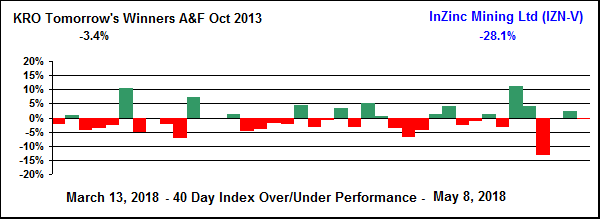 |
| Apr 23, 2018 | Discovery Watch with HoweStreet.com - 0:12:51 |
| Apr 20, 2018 | SVH Tracker: Drilling underway at West Desert as InZinc warrant clippers flip their stock |
| Jan 19, 2018 | Discovery Watch with HoweStreet.com - 0:08:00 |
| Jan 9, 2018 | SVH Tracker: Recommendation Strategy for InZinc Mining Ltd |
| Nov 24, 2017 | Discovery Watch with HoweStreet.com - 0:21:57 |
| Nov 20, 2017 | SVH Tracker: InZinc to raise $3 million for West Desert drilling |
| Oct 13, 2017 | Discovery Watch with HoweStreet.com - 0:08:01 |
| Sep 13, 2017 | Discovery Watch with HoweStreet.com - 0:10:20 |
| Aug 25, 2017 | SVH Tracker: InZinc management wants to launch West Desert but does it have the right stuff? |
| Jan 31, 2017 | SVH Tracker: InZinc the most overlooked zinc junior |
| Namibia Rare Earths Inc, led by President and CEO Gerald McConnell, listed on the TSX on April 14, 2011 after completing a $25 million IPO at $0.80 to fund its 100% owned Lofdal rare earths project in Nambia. NRE was initially controlled by Endeavour Mining Inc, which inherited Lofdal when it made a takeover bid in for Etruscan Resources Inc in 2010. Lofdal was an IOCG prospect for Etruscan in 2005-2008, but the exploration focus shifted to the carbonatite complex whose overall light rare earth footprint exhibited localized heavy rare earth enrichment. Endeavour spun out Lofdal as a separate company to take advantage of the rare earth boom which the junior largely missed because it did not publish an initial 43-101 resource estimate until July 2012. NRE did establish an indicated and inferred resource of 1,650,000 tonnes grading 0.56%-0.62% TREO in a 10-25 m thick dyke with a 650 m strike measured downdip 150 m in Area 4 but known to extend at least 400 m. Although low tonnage and low grade the Area 4 deposit has 85% heavy rare earths due to the mineral xenotime. NRE delivered a PEA in October 2014 for a 2,500 tpd open-pit operation with a 7 year mine life but which needs higher rare earth prices to justify development. NRE is awaiting a mining lease to secure title before doing further work. In Feb 2018 NRE issued 64 million shares to Geoko Namibia for a portfolio of Namibian projects which include the Kunene sediment-hosted cobalt-copper project to the west of the Opuwo project of Celsius Resources, the Black Range graphite deposit, and the Warmbad project covering a swarm of pegmatite dykes with lithium potential. |  |
| Issued: | 158,703,500 | Working Capital: | $78,615 |
| Diluted: | 184,125,121 | As Of: | November 30, 2017 |
| Membership Start Date | September 26, 2013 | Price at Start | $0.20 |
| Membership backdated to | April 14, 2011 | Membership Quantity | 5,000 |
| Quick Note by JK on September 26, 2013: Namibia Rare Earths Inc is interesting because it may have the fastest near term solution to the heavy rare earth supply problem that was eclipsed by the overall rare earth price bubble which boosted light and heavy REO prices tenfold in 2010-2011 from their post-Crash bottoms in 2009. Lynas and Molycorp are in the midst of commissioning their light rare earth dominated Mt Weld and Mountain Pass deposits which will more than adequately supply the non-Chinese demand that remains after the demand destruction caused by the bubble. These mines, however, will not solve the shortage of heavy rare earths, which is a problem looming even for China which within ten years is expected to have depleted its ion adsorption clay deposits that are the main source of heavy rare earths. There are world-class heavy rare earth enriched deposits such as Strange Lake and Norra Karr in the pipeline, but high capital costs, metallurgical complexity, and logistical obstacles could push production into 2020 and beyond. NRE could slip into the front of the development pipeline because it owns 100% of the Lofdal carbonatite complex in mining-friendly Namibia where it has outlined a small open-pittable zone known as Area 4 that is very enriched with heavy rare earths because the mineralization is dominated by xenotime, a mineral whose cracking characteristics are well understood by the rare earth industry. The resource is neither large nor high grade, but it is just the right size to fast-track as a western alternative to Chinese heavy rare earth supply. Furthermore, the likelihood is high that future exploration will discover similar zones that could keep a mine operating far beyond depletion of Area 4. The company is conducting critical metallurgical studies which will determine if a concentrate can be produced from which the radioactive thorium has been stripped, which would make NRE very attractive as a buyout target or partner for entities that have heavy rare earth separation capacity. NRE, which was spun out from Etruscan when it was taken over by Endeavour, has the same Africa experienced management team and recently acquired strong shareholders who support management's goal of turning NRE into a critical metals supplier that goes beyond producing heavy rare earths. |
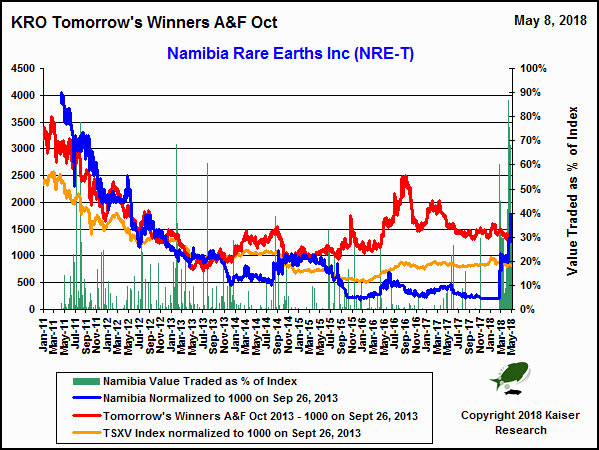 |
 |
| Nevada Exploration Inc is the exploration vehicle for an innovative gold prospecting approach developed by Wade Hodges and Ken Tullar during the past decade to look for blind gold deposits buried beneath the gravels of Nevada's basins. NGE has collected over 6,000 water samples in northern Nevada. Several dozen potential hotspots have been identified, of which NGE has a 100% interest in Grass Valley just south of the Cortez Hills Mine and in South Grass Valley 30 km to the south. Both are blind targets with coincident gold and Carlin type pathfinder element anomalies. Key to Nevada 2.0 is John Muntean's "subduction slab rollback" theory which suggests that Carlin-type gold deposits were created from 45-25 million years over a 300 km stretch of northern Nevada where the older overthrusting of Lower Plate carbonates by Upper Plate siltstones created favorable deposit settings wherever deep-seated faults exist. The subsequent extension that created the basin and range topography buried half of Nevada's potential gold endowment under difficult to explore basin gravels. Most of Nevada's 300 million ounce known gold endowment has been found in the exposed ranges or by projecting structures and favorable host rocks under shallow gravel cover. The other half lies under gravel in places where the ranges offer no clues about nearby hidden riches. Finding the missing half of Nevada's gold represents the greatest gold exploration frontier in North America. NGE has pioneered the only effective way to "see" gold through gravel cover. In 2017 NGE deployed its custom Scorpion Rig to collect 3D samples on its Kelly Creek project east of the former 5 million oz Lone Tree Mine to outline a large blind hydrothermal system under gravel cover which it intends to drill in 2018. It has also established a drill ready groundwater based target at South Grass Valley. | 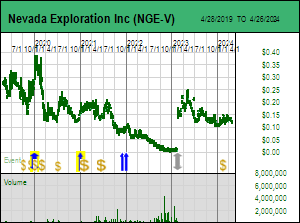 |
| Issued: | 55,424,068 | Working Capital: | $752,244 |
| Diluted: | 70,907,702 | As Of: | January 31, 2018 |
| Membership Start Date | September 26, 2013 | Price at Start | $0.11 |
| Membership backdated to | January 4, 2011 | Membership Quantity | 9,524 |
| Quick Note by JK on September 26, 2013: Nevada Exploration Inc is an exploration junior which has developed a new method for generating Carlin-type gold targets in the gravel covered basins of northern Nevada where more than 300 million ounces have been discovered during the past three decades by majors like Barrick and Newmont. These ounces are mainly confined to 3 trends known as Carlin, Cortez and Getchell and were mostly found by projecting mineralization and structures exposed in Nevada's mountain ranges under the basin gravel cover. Extensive exploration of the ranges has exhausted such targets, with new gold discoveries in Nevada arising largely through minesite exploration. One would think that Nevada's gold discovery days are over, but a new academic theory proposed by Professor John Muntean postulates that Nevada's gold endowment was created over a 20 million year period during which a foundering subduction slab unleashed a front of magmatism that swept through a 400 km region that had been structurally prepared for the deposition of large high grade gold deposits known as Carlin type. The situation was further complicated by the later creation of the basin and range topography which down-dropped half of the Carlin deposits and buried them under gravel. The implication of Muntean's theory is that Carlin type deposits will exist wherever mantle penetrating structures are present as already demonstrated by the known "trends". The prevailing view is that the location of these trends is already established, but a database created by NGE through a regional geochemical sampling program suggests otherwise. NGE's target generation method involves collecting groundwater samples in the basins and assaying them for gold and Carlin pathfinder elements. Over 5,000 samples have established 20 high priority "golden haystacks" under gravel cover located off the main "trends", with another 80 targets requiring followup. NGE possesses a secret map to Nevada's missing gold that would become the most valuable treasure map in history the instant one of these targets is turned into a major gold discovery. It is not a question of if but simply when, for a groundwater test study done in 1995 by a government geologist geochemically revealed the location of the 15 million ounce Twin Creeks deposit that was found by grid drilling gravels on a target projected from the mountains. |
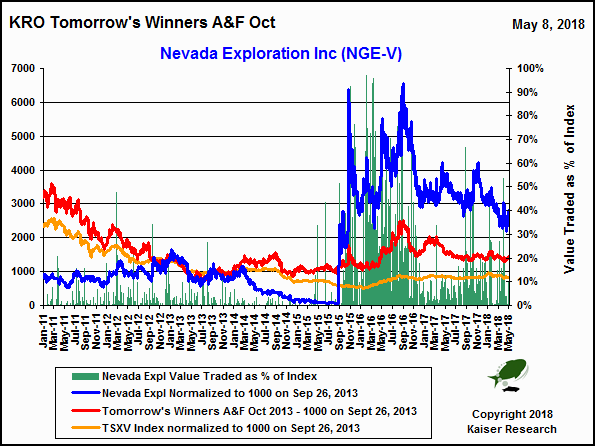 |
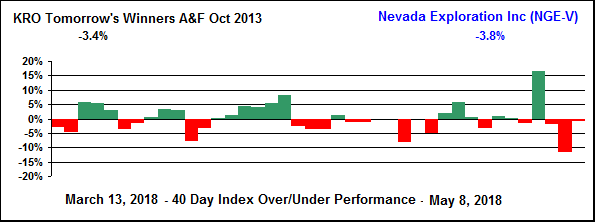 |
| Jan 19, 2018 | Discovery Watch with HoweStreet.com - 0:14:50 |
| Dec 8, 2017 | Discovery Watch with HoweStreet.com - 0:00:00 |
| Oct 13, 2017 | Discovery Watch with HoweStreet.com - 0:00:00 |
| Sep 13, 2017 | Discovery Watch with HoweStreet.com - 0:13:00 |
| Jun 23, 2017 | Discovery Watch with HoweStreet.com - 0:21:13 |
| Sep 19, 2016 | Bottom-Fish Comment: NGE rolls out its new Scorpion rig |
| Jul 4, 2016 | Bottom-Fish Comment: Bottom-Fish Recommendation Strategy for Nevada Exploration Inc |
| Oct 26, 2015 | Special Interest Comment: NGE's Grass Valley play emerges from the McEwen morgue alive and well |
| Sep 1, 2015 | Bottom-Fish Comment: Recommendation Strategy for Nevada Exploration Inc |
| Aug 11, 2015 | Bottom-Fish Comment: Ex-Uranerz Chairman leads rescue of NGE and its Nevada gold-in-groundwater exploration strategy |
| Uravan Minerals Inc is a uranium explorer led by CEO Larry Lahusen which has developed a remote sensing exploration tool that involves collecting clay samples in the Athabasca Basin and geochemically analyzing them for radiogenic lead isotopes as well as other uranium deposit related pathfinder elements. The method is based on the theory that microbes digest sulphides associated with uranium deposits at the basement-sandstone unconformity and emit gases that serve as a transport medium for elements liberated from the deposit. These gases travel from depths of 1,500 m along fracture systems where they are absorbed by clay particles at the surface. Uravan has worked with Queens' Facility for Isotope Research to develop protocols for establishing anomalies and has successfully conducted case study surveys over the Cigar Lake and Centennial deposits. The Centennial study completed in 2013 was a major success in that it clearly outlined a uranium deposit at an 800 m depth whose physical location is offset from graphite conductors. CMIC through its Footprints Project is undertaking a study of McArthur River area that will include Uravan's radiogenic lead isotope sampling method which will become public domain in late 2018. Uravan has a 70% farm-in deal with Cameco on the Halliday and Stewardson projects where Cameco can earn 51% by spending $7 million by Apr 2018. An airborne geophysical survey on the Stewardson project yielded two anomalies. Cameco drilled 2 holes on target Area A in 2014 with negative results interpreted as indicative of a deeper basement hosted deposit out of economic reach. During 2015 Cameco drilled 2 holes in the northern part of Area B, one of which intersected low grade uranium. Cameco has until April 2018 to spend another $1.4 million to vest for 51% and give it the right to go to 70% by spending a further $15 million. Cameco has deferred further work on Stewardson to 2017. Uravan also holds 100% of the Outer Ring project which has a 10 km geochemical anomaly in the untested southern part and needs a geophysical survey. A geophysical survey in 2016 revealed a major conductor associated with the ORX geochemical anomaly. Uravan plans to start a 3 hole drill program in late September 2016. |  |
| Issued: | 42,329,012 | Working Capital: | $155,440 |
| Diluted: | 45,954,012 | As Of: | September 30, 2017 |
| Membership Start Date | September 26, 2013 | Price at Start | $0.07 |
| Membership backdated to | January 4, 2011 | Membership Quantity | 14,286 |
| Quick Note by JK on September 26, 2013: Uravan Minerals Inc is headed by a technical team that has 40 years of experience in the Athabasca Basin, home to the world's richest uranium deposits. The Fukushima nuclear power plant disaster in 2011 has cast a pall on the outlook for uranium as Japan and Germany shift away from nuclear energy, and we may see uranium prices trapped below $60/lb for quite a few years as utilities unwind their stockpiles through the spot market. The weak uranium price will hurt the profitability of existing mines and low grade deposits under development, but this weakness is irrelevant for the valuation of new high grade unconformity style uranium discoveries in the Athabasca that will not be in production any earlier than 5 years from now. The reality is that many new reactors remain in the development queue. The South Patterson Lake discovery made by Fission and Alpha is shaping up as potentially world class, and is sowing the seeds for a renewed area play in the Athabasca Basin. Unfortunately there is limited room for making discoveries by chasing radioactive boulders as was done at SPL, so the juniors would seemingly have to rely on the conventional method of drilling geophysical targets at the unconformity between the basement rocks and basin sandstone where these uranium deposits lurk in association with graphite conductors. But there are many more graphite targets than uranium deposits, as the owners of the claims that blanket the flanks of the Athabasca Basin will unhappily testify. There are numerous untested targets, incompletely tested targets due to the smaller footprint of the uranium deposit relative to the graphite conductor, and as yet unsuspected targets that new interpretation methods will bring to light. Uravan has only a handful of claims, with the main ones farmed out to Cameco, but it does have a new target generation method that was tested on the Cigar Lake deposit and is currently being tested on the Centennial deposit. Uravan has established that the ratio of a lead isotope created by the decay of uranium to regular lead isotopes is indicative of the presence of a uranium deposit over 800 metres deep. Uravan generates geochemical uranium targets by collecting clay and tree-core samples and evaluating radiogenic lead isotope ratios. These geochemical targets can prioritize geophysical targets for drill testing; Uravan holds the keys to a new discovery boom in the Athabasca Basin. |
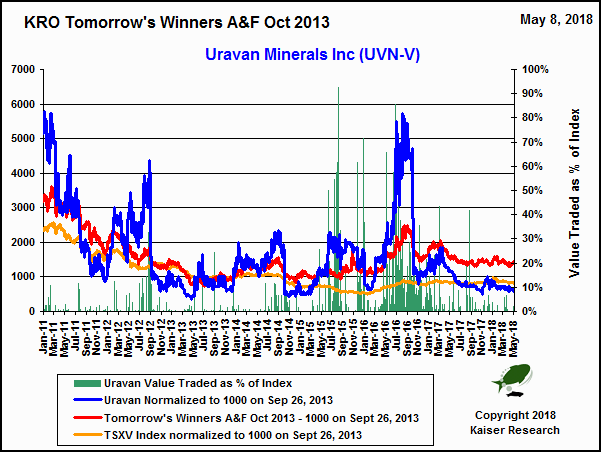 |
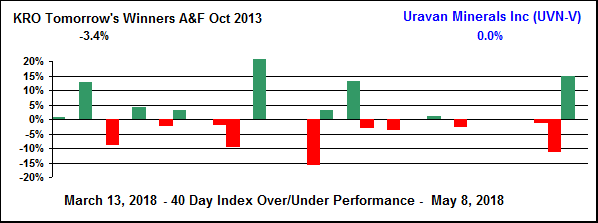 |
| Nov 17, 2017 | Discovery Watch with HoweStreet.com - 0:05:53 |
| Sep 1, 2017 | Discovery Watch with HoweStreet.com - 0:03:04 |
| Mar 10, 2017 | Discovery Watch with HoweStreet.com - 0:18:05 |
| Oct 13, 2016 | Discovery Watch with HoweStreet.com - 0:00:00 |
| Oct 11, 2016 | SVH Tracker: Uravan focus to shift from Outer Ring bust to Stewardson in 2017 with or without Cameco |
| Oct 6, 2016 | Discovery Watch with HoweStreet.com - 0:11:08 |
| Sep 19, 2016 | SVH Tracker: Uravan plans to drill ORX anomaly at Outer Ring in October |
| Jul 25, 2016 | SVH Tracker: 2D Inversion reveals ORX target as potentially McArthur's Mother |
| Jun 29, 2016 | SVH Tracker: Uravan's Outer Ring geophysical survey yields multi-dataset supported target |
| May 18, 2016 | Bottom-Fish Comment: Canalaska options Athabasca Kimberlite Project to De Beers |
| Index Members Delisted or Closed Out |
|---|
| Probe Mines Ltd, headed by CEO David Palmer, is focused on the 100% owned Borden gold project in the Kapuskasing area of Ontario southwest of Timmins. Borden was a 2010 grassroots discovery for which an open-pittable resource of 4.3 million ounces at 0.5 g/t cutoff was reported in 2012. In late 2012, however, the exploration focus shifted to a new style of Archean lode mineralization at the eastern end of the Borden zone which had a significantly higher grade. The High Grade Zone (HGZ), which is an underground mining target, had been traced for 1,100 m as of the end of 2013 and is the focus of a winter ice drilling campaign during H1 of 2014 to test an additional 1,000 m of potential strike. An initial resource estimate is expected in Q2 of 2014, followed by a PEA in Q3, which would form the basis for an underground drilling campaign as part of a PFS for an underground 2,000-3,000 tpd mine. In the Ring of Fire region of northern Ontario, Probe owns the Black Creek chromite project with a resource of 8 million tonnes grading 40% Chromium (7.4 billion pounds). The possibility that Cliffs might eventually buy Black Creek has diminished since Cliffs suspended development work in 2013 due to the failure of the government to address First nations and infrastructure issues. |  |
| Issued: | 90,794,727 | Working Capital: | $34,454,460 |
| Diluted: | 111,162,227 | As Of: | October 31, 2014 |
| Membership Start Date | September 26, 2013 | Price at Start | $2.17 |
| Membership End Date | March 16, 2015 | Price at End | $4.33 |
| Membership backdated to | January 4, 2011 | Membership Quantity | 461 |
| Quick Note by JK on September 26, 2013: Probe Mines Ltd is a well financed junior with a competent technical team that in 2010 made a grassroots gold discovery in Ontario called Borden which has a low grade open-pittable gold resource of at least 4 million ounces. Gold's sharp decline during 2013 into a $1,200-$1,400 trading range haunted by $1,000 gold investment bank predictions has put in question the wisdom of developing large low grade deposits. Probe, however, escaped the market sell-off because in late 2012 drilling encountered a much higher grade zone of mineralization for which a resource estimate is expected in Q4 of 2013. Initial drill results suggest potential for a medium grade resource in excess of 1 million ounces which could be underground mined and blended with the lower grade open pit mined ore to support a robust economic study at current gold prices. There is potential for the grade and thickness to blossom as drilling follows the zone down-plunge, which cannot happen until winter freezeup because the zone extends under a lake. What makes the new zone especially interesting is that it is a quartz hosted Archean lode type of mineralization found in the Timmins and Red Lake districts and not expected in this part of Ontario due to its metamorphic history. A similar stigma afflicted the region to the west prior to the 1982 discovery of the medium grade 20 million ounce Hemlo deposit. So not only is Borden an emerging discovery within a discovery, but potentially an entirely new district that hosts multiple zones of this nature, much of whose relevant geology Probe already controls. Probe thus offers leverage to higher gold prices for the existing low grade resource, exposure to the discovery of many new ounces that are valuable at prevailing gold prices, and bluesky exploration potential on a district wide scale. |
 |
|
| |
| | You can return to the Top of this page
|
|